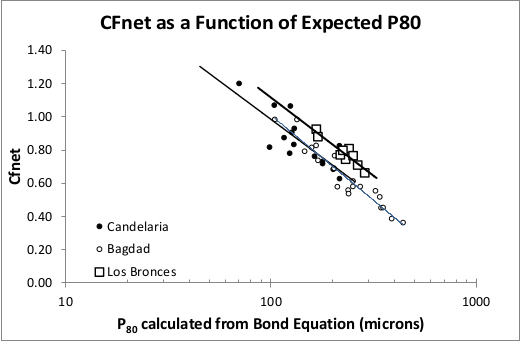Difference between revisions of "Model:Amelunxen SGI"
(→CFsag calibration factor) |
(→CFsag calibration factor) |
||
| Line 41: | Line 41: | ||
* Base value, SAB circuit (no pebble crushing, ~6 inch SAG feed), CF<sub>sag</sub> = 1.00 |
* Base value, SAB circuit (no pebble crushing, ~6 inch SAG feed), CF<sub>sag</sub> = 1.00 |
||
* Pebble crushing, SABC circuit, CF<sub>sag</sub> = 0.85 |
* Pebble crushing, SABC circuit, CF<sub>sag</sub> = 0.85 |
||
| − | * Pre-crushing, (fine SAG feed, -120 mm SAG feed), CF<sub>sag</sub> = 0.90 |
+ | * Pre-crushing, (fine SAG feed, -120 mm SAG feed<sup>Custer et al, CMP 2001</sup>), CF<sub>sag</sub> = 0.90 |
* Pre-crushing and pebble crushing, CF<sub>sag</sub> = 0.85 × 0.90 = 0.77 |
* Pre-crushing and pebble crushing, CF<sub>sag</sub> = 0.85 × 0.90 = 0.77 |
||
Revision as of 05:52, 19 November 2015
Contents
Amelunxen SGI Model
This is a SAG or AG mill plus ball mill model that estimates the specific energy consumption (ESAG) using the equation by Amelunxen (2014) and the classical Bond work index equation substituting CFball in the place of the Rowland efficiency factors.
The model requires manual calibration factors for both equations (CFSAG and CFball, respectively) and is very sensitive to the settings used for these factors.
Testwork Required
Required parameters
- F80, µm is the 80% passing size of the fresh feed to the circuit (expected to be a Bond-compatible size distribution).
- P80, µm is the 80% passing size of the circuit product (expected to be a Bond-compatible size distribution).
- Availability, expressed as a decimal (0.90 = 90% availability) is used to convert t/h to t/d.
- Ball mill Operating strategy when circuit is SAG-limited (note, fixed speed can only be vary P80)
Optional parameters
- Description and Comment are optional text fields
- Maximum t/h limit is a t/h throughput above which a warning message is displayed (but does not actually limit the throughput).
- T80 min and T80 min override the transfer size restrictions built into the model
- Ball mill work index adjustment used to adjust WiBM for different P80 sizes.
- coefficient (a), the fitted coefficient to the adjustment equation
- exponent (b), the fitted exponent to the adjustment equation
- CFball calibration factor, model tuning factor for EBM
- CFsag calibration factor, model tuning factor for EASAG
Formulae
CFsag calibration factor
The CFsag factor is used to reflect the effect of pebble crushing and pre-crushing on the overall circuit performance.
- Base value, SAB circuit (no pebble crushing, ~6 inch SAG feed), CFsag = 1.00
- Pebble crushing, SABC circuit, CFsag = 0.85
- Pre-crushing, (fine SAG feed, -120 mm SAG feedCuster et al, CMP 2001), CFsag = 0.90
- Pre-crushing and pebble crushing, CFsag = 0.85 × 0.90 = 0.77
CFball calibration factor
The CFball is a manually picked value used to lump the phantom cyclone effect and the variety of Rowland efficiency factors into a single factor. This value is usually picked based on a mill survey, or taken from a diagram such as Figure 5 from Becerra & Amelunxen (2012)Bibliography, reproduced below.
 (CFnet is the term used by Becerra & Amelunxen for CFball)
(CFnet is the term used by Becerra & Amelunxen for CFball)
If the CFball value is left blank, then the fitted "Los Bronces" curve is used (squares in the Becerra & Amelunxen diagram).
Transfer size
The transfer size assumed in a Amelunxen SGI model is described as being "as would be measured in a plant survey" (uncorrected for the extra fines, the phantom cyclone effect). This is different to the basis of the various Bond models where the transfer size is a synthetic value that implies the removal of the extra fines.
In practical terms, running an SGI model will require relaxing the upper T80 constraints (the default constraints are tuned to the Bond models). Upper limits of 5000 µm or 6000 µm are not uncommon when simulating Andean copper porphyry type ores in SAB or SABC-A configurations.

